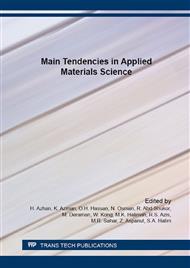p.690
p.697
p.702
p.706
p.712
p.719
p.726
p.734
p.740
Non-Resonance Acousto-Optics Signal Analysis from Photonics Microphone Using 1 mW Laser
Abstract:
This paper presents an acousto-optics analysis on free space optical signals modulated by two distinguishable non-resonant acoustic waves. The acoustic waves were directed at two different directions and locations along a laser beam and created non-interference modulated optical signals. The photonics microphone deploys low-powered eye-safe continuous-wave 633-nm laser; high-speed photodiode and a series of Fourier lenses. Two transducers generating 20 Hz to 20 kHz acoustic waves were directed across the laser beam. The receiving modulated signal was filtered and amplified electronically by two sets of passive bandpass filter separated by a transimpedance amplifier and connected to a computer for analysis. The signal was further digitally filtered and amplified to enhance the signal-to-noise ratio via MATLAB software. These signals were analyzed in time and frequency domains using Fast Fourier Transform (FFT) and Spectrogram. It was found that the recorded signals demonstrated higher signal intensities for lower acoustic frequencies with digital signal-to-noise ratio (SNR) ranging from 10.77 to 71.92 for frequency of 1 kHz to 20 kHz and 20 Hz to 1 kHz respectively. The frequencies of both transducers were simultaneously swept through from 20 Hz and 20 kHz respectively. These scanning frequencies approached one another and crossover with no resonant frequency was observed. This illustrates that it is able to detect multiple acoustic signals for any given frequencies along the laser beam and found its applications in stealth sound detection and long range sound sensor. Though low-powered 1-mW laser was used, a relatively high signal-to-noise ratio with clear-recorded playback was achieved.
Info:
Periodical:
Pages:
740-747
Citation:
Online since:
March 2016
Price:
Сopyright:
© 2016 Trans Tech Publications Ltd. All Rights Reserved
Share:
Citation:


